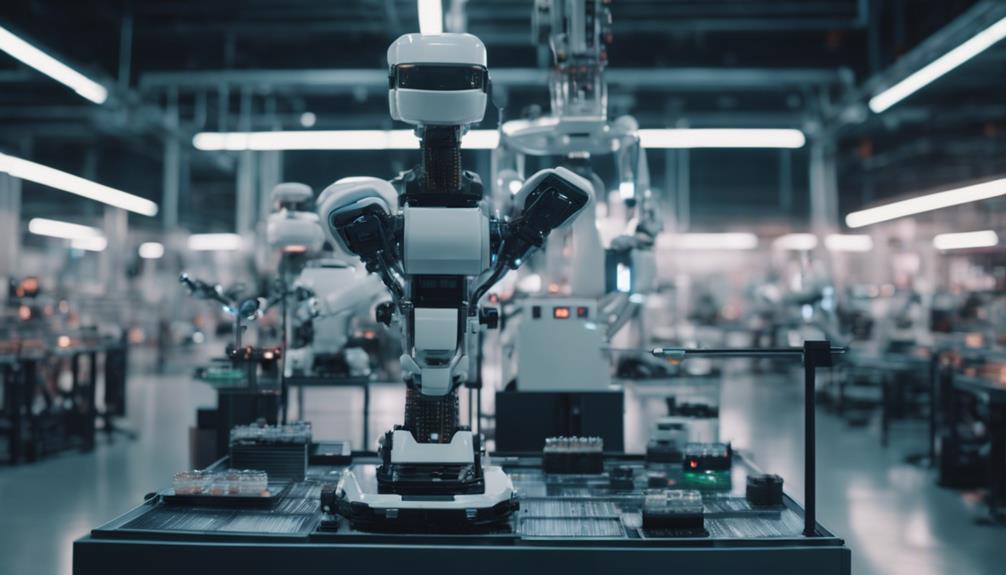I've found that AI can drastically slash costs and elevate efficiency across various domains. Automating repetitive tasks can boost productivity by 40%, while data-driven ad spend optimization enhances ROI. Segmenting customers increases conversion rates and satisfaction. Dynamic pricing responds to market shifts instantly, driving revenue. Supply chain management benefits from predictive maintenance, reducing downtime and costs. Enhancing quality control minimizes waste. Streamlining operations and automating customer service cuts errors and boosts efficiency. Finally, AI tools for workflow management and decision-making streamline processes and improve accuracy. Stick around to uncover more details on how these strategies can transform your business.
Key Takeaways
- Automate repetitive tasks to elevate workforce productivity and focus on higher-value projects.
- Utilize dynamic pricing to instantly respond to market demands and drive revenue optimization.
- Optimize supply chain management with predictive maintenance to reduce costs and prevent downtime.
- Personalize marketing through targeted customer segmentation to boost engagement and ROI.
- Streamline operations by automating tasks to enhance efficiency and achieve significant cost savings.
Workforce Productivity Optimization
By leveraging AI to automate repetitive tasks, businesses can greatly enhance workforce productivity and redirect employees towards more strategic initiatives. I've seen firsthand how AI can elevate efficiency gains by up to 40%, driving significant cost reduction.
When employees aren't bogged down by mundane activities, they can focus on complex problem-solving and innovative projects. This shift not only boosts morale but also aligns with modern business goals of maximizing workforce productivity.
AI's ability to provide data-driven insights further refines operations, leading to more accurate forecasts and minimized risks. By assessing specific processes for AI integration, companies can identify time-consuming tasks ripe for optimization.
Ultimately, embracing AI isn't just smart; it's a game-changer for efficiency and cost-effectiveness.
Conversion Cost Reduction
When it comes to reducing conversion costs, AI plays a pivotal role in streamlining ad spend and optimizing landing pages.
I've seen how targeted AI algorithms can guarantee every dollar spent on advertising reaches the right audience, maximizing ROI.
Streamlining Ad Spend
Harnessing the power of AI, businesses can dramatically reduce conversion costs by identifying and utilizing the most effective ad channels and targeting strategies.
With AI algorithms, companies can dive deep into data analytics to reduce operational costs and streamline spend management. This approach not only maximizes ROI but also curtails revenue leakage by ensuring every dollar spent on advertising is optimized.
AI tools continuously monitor and adjust ad performance in real-time, allowing for agile responses to market changes. By leveraging these advanced technologies, businesses can make data-driven decisions that enhance efficiency and effectiveness.
In a world where every cent counts, AI-driven ad optimization is a game-changer for those committed to innovative, cost-effective marketing solutions.
Optimizing Landing Pages
Moreover, optimizing landing pages with AI isn't just a technological upgrade; it's a strategic move that can greatly reduce conversion costs and drive higher engagement.
AI-driven personalization can boost landing page conversion rates by 80%, tailoring content to individual user preferences.
Integrating A/B testing with AI enables a 30% increase in conversion rates by swiftly identifying the most effective elements.
Additionally, AI can analyze user behavior to optimize landing page layouts, ensuring every element is strategically placed for maximum impact.
AI-powered chatbots enhance engagement, leading to a 50% rise in conversions by providing instant assistance and personalized recommendations.
Embracing these AI-driven strategies isn't optional—it's essential for any business aiming to lead in today's competitive landscape.
Targeted Customer Segmentation

AI-driven targeted customer segmentation revolutionizes the way businesses engage with their audience by greatly boosting conversion rates and marketing ROI. By adopting AI, companies can achieve significant cost savings while improving customer interactions. AI algorithms analyze customer data to identify patterns and preferences, enabling personalized marketing messages that lead to higher engagement.
Consider these benefits:
- Increased Conversion Rates: AI-driven segmentation can lead to a 10% to 30% rise in conversions.
- Enhanced Marketing ROI: Businesses see a 25% increase in ROI.
- Customer Satisfaction: Tailored messaging boosts customer satisfaction and loyalty.
- Cost Efficiency: Streamlined marketing efforts reduce unnecessary expenditure.
Embracing AI adoption for targeted customer segmentation isn't just forward-thinking; it's a strategic move that drives measurable results.
Smart Pricing Strategies
AI-powered pricing algorithms can transform how businesses set and adjust prices in real time, leading to enhanced revenue and market competitiveness. By leveraging dynamic pricing strategies, companies can respond instantly to market demands, adjusting prices to capture the highest possible revenue.
These algorithms utilize machine learning to refine prices, ensuring they're optimized for both revenue and competitiveness. Additionally, AI can identify pricing anomalies, allowing businesses to correct errors and prevent revenue leakage.
In industries like retail, this real-time adaptability can be revolutionary. Embracing AI-driven pricing solutions isn't just about keeping pace; it's about leading the market. With precise revenue optimization, businesses can secure a significant edge over competitors, driving sustainable growth and profitability.
Supply Chain Management

While smart pricing strategies can greatly enhance revenue, the real game-changer lies in integrating AI into supply chain management to slash operational costs and boost efficiency.
AI implementation can reduce these costs by up to 30% and improve efficiency by up to 40%. By analyzing historical data, AI algorithms can forecast demand, manage inventory, and streamline operations.
Here's why AI is indispensable:
- Cost savings: AI optimizes resource allocation and reduces waste.
- Predictive maintenance: Prevents costly downtime and extends asset lifespan.
- Demand forecasting: Uses historical data to predict market needs accurately.
- Inventory management: Ensures best stock levels, reducing holding costs.
In a data-rich supply chain environment, AI's potential for cost savings and operational improvements is unmatched.
Predictive Maintenance
Predictive maintenance, fueled by AI, anticipates equipment failures, slashing downtime and unplanned maintenance costs. By analyzing historical data and sensor readings, AI algorithms pinpoint failure patterns, enabling proactive maintenance scheduling.
This AI-driven approach not only extends asset lifespan but also notably reduces operational costs. Efficient asset management becomes achievable as AI forecasts streamline maintenance, enhancing overall asset efficiency.
The result? Improved supply chain efficiency and minimized downtime, translating into substantial cost savings. For industries seeking innovation, AI-driven predictive maintenance is a game-changer.
It leverages data insights to optimize maintenance schedules, ensuring that resources are used effectively and operational disruptions are minimized. Embracing this strategy is essential for cutting costs and boosting productivity.
Quality Control Enhancement

Building on the success of predictive maintenance, enhancing quality control with AI-driven systems can drastically reduce defects and improve overall product quality. A survey by McKinsey highlights how AI can transform quality control, achieving up to 90% defect reduction in manufacturing processes. By predicting potential defects before they occur, AI doesn't just enhance quality but also drives significant cost savings.
Consider these benefits:
- Anomaly Detection: Machine learning algorithms identify and rectify issues early.
- Automation: Faster, more accurate inspections reduce manual errors.
- Waste Minimization: Less waste and rework lead to direct cost savings.
- Improved Product Quality: Enhanced quality control means higher customer satisfaction.
Integrating Artificial Intelligence (AI) into quality control isn't just innovative; it's a strategic move towards operational excellence.
Streamlined Operations
AI's transformative power lies in its ability to streamline operations by automating repetitive tasks and enhancing overall efficiency. By leveraging AI transformation, businesses can achieve significant cost savings.
Automating repetitive tasks reduces the need for manual labor, minimizes human errors, and accelerates task completion. Predictive maintenance powered by AI identifies potential equipment failures before they occur, reducing downtime and operational costs. AI algorithms also optimize maintenance schedules, extending asset lifespan and boosting supply chain efficiency.
These enhancements streamline business operations, allowing for better decision-making and increased productivity. Ultimately, AI transformation is key to driving down costs and improving operational efficiency, making it an indispensable tool for any forward-thinking organization.
Customer Service Automation

In today's fast-paced business environment, deploying AI-driven customer service automation is essential for reducing costs and enhancing customer satisfaction. By integrating AI, companies can achieve significant cost savings and efficiency gains.
- Cost savings: AI can handle up to 80% of routine queries, cutting operational costs by up to 30%.
- Efficiency: AI-driven chatbots improve response times by 99% and can manage multiple interactions simultaneously.
- Improving customer satisfaction: Automation reduces errors and streamlines processes, leading to higher satisfaction.
- Personalized interactions: AI enables tailored customer experiences, boosting cross-selling and upselling opportunities by 10-20%.
Embracing AI in customer service isn't just smart—it's transformative for any business aiming to innovate and thrive.
Workflow Management Tools
Moreover, notably as AI revolutionizes customer service, it also transforms workflow management by streamlining processes and slashing operational costs. AI-driven workflow tools are game-changers for any organization. By optimizing task allocation, these advanced management systems boost team productivity by 25%. Not only do they cut down operational costs by up to 30%, but they also markedly enhance process efficiency, leading to a 40% improvement.
Errors and rework drop by 20% with AI-driven solutions, making operations smoother and more reliable. Additionally, decision-making becomes quicker and more accurate, reducing decision-making time by 15%.
If you're looking to innovate and achieve substantial cost savings, investing in AI-enhanced workflow management tools is a strategic move you shouldn't overlook.
Frequently Asked Questions
How to Use AI to Save Money?
I use AI to save money by optimizing energy consumption, improving inventory management, implementing dynamic pricing strategies, and enabling predictive maintenance. These AI-driven methods streamline operations and reduce costs, fostering innovation and efficiency in my business.
How Can AI Reduce the Cost of Care?
AI's like a crystal ball for healthcare. Predictive analytics, medical imaging, patient triage, and drug discovery all reduce costs by streamlining processes, improving accuracy, and speeding up treatments. It's a game-changer for cost-effective, quality care.
How Will AI in the Workplace the Future of Business Efficiency and Cost Savings?
AI will revolutionize business efficiency and cost savings by boosting employee productivity, enabling predictive maintenance, automating processes, and offering deep customer insights. I'm convinced these innovations will drive significant competitive advantages and operational excellence.
How to Use AI to Build a Budget?
Using AI to build a budget might seem complex, but predictive analytics can simplify financial forecasting. AI's expense tracking refines budget recommendations, dynamically adjusting to trends. It's insightful, ensuring we optimize resources and stay innovative.
Conclusion
I've explored these ten terrific AI-driven cost-saving strategies, and I'm convinced they can revolutionize any business.
By optimizing workforce productivity, reducing conversion costs, and refining customer segmentation, companies can see significant savings.
Smart pricing, superior supply chain management, and enhanced quality control guarantee efficiency.
Streamlined operations, automated customer service, and effective workflow management tools tie it all together.
Implementing these strategies isn't just smart—it's essential for staying competitive in today's fast-paced market.





